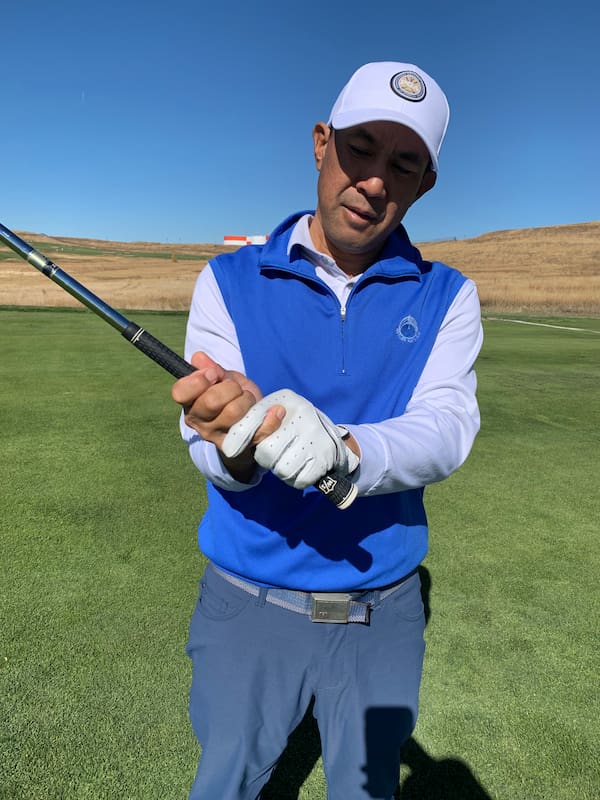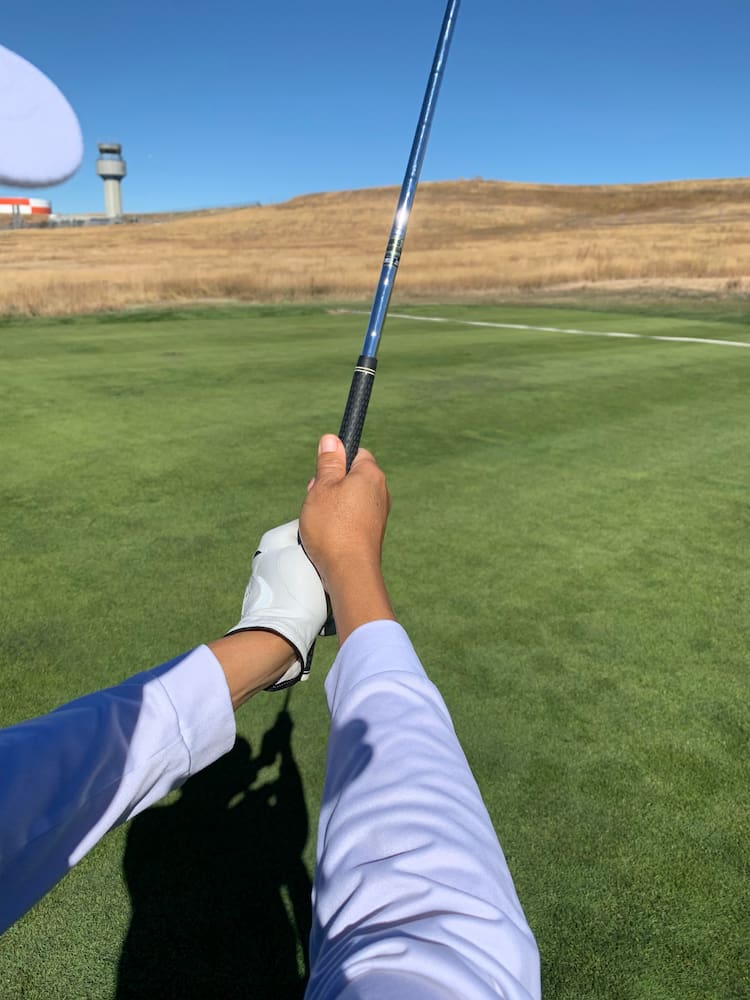I consider it the Lifeline. Holding the golf grip properly won’t get you your perfect swing but an incorrect golf grip can certainly derail you and keep you from being consistent. Every golfer’s grip is different but as long as you can prevent yourself from over-controlling and over-manipulating the golf club and release the club in the backswing after clearing your left side on downswing, you’re on your way to a great golf swing.
Most golfers have a tendency to use their hands too much and then leave the body to go “along for the ride.” What consistent ball strikers feel when they make good contact is the clubbed making contact with the ball and a good turn through the ball. When you mostly feel your hands trying to make contact, you won’t feel your body turn as well to your finish.
After seeing hundreds and hundreds of grips, the biggest thing I hate and love doing is changing a golf grip.
- I hate changing the golf grip because it usually freaks them out since its probably the most important thing they feel when they hit a golf ball
- I love changing the golf grip because it gets them a completely different feeling how to release the club and an easier way to strike a ball
Where should the golf grip be in your hands?
The main part of where you mostly feel the golf grip is in your fingers. It is usually a natural instinct to grip something tighter when something is on your palm. However, it is also an instinct that you would grip something lightly when something in your fingers.

When I change my student’s golf grip, I exaggerate the grip a bit in the fingers and how the hands are angled onto the grip. For intermediate and beginning students, I have them releasing the club right away when the grip is looser and more in the fingers. The reason for the exaggeration is because it is very common for a student to inch back to their old/more comfortable golf grip without them knowing.
I’d say 9/10 students that return to the following lesson after the grip change needs another reminder about the grip more in the fingers.
Their first reaction is how heavy the clubbed feels and how much they can rely on the weight of it. The weight is what you want to feel so you can use that to create MOMENTUM. When you create momentum, we want the body to react to it so the body will turn more naturally and create better rhythm and eventually tempo.
Step by Step Guide on how to hold a golf club
Left Hand Grip (right hand golfer)…
Most vital to create an easier release of the clubhead. If you have trouble with contact, try changing your left (top) hand grip.
- Grip club out higher in front of you
- Lay the grip onto the middle of the fingers with an open hand with a slight angle closer to the index finger tip to the base of pinky
- Let fingertips curl around grip
- Let rest of hand just lay over on top of grip
- You should feel the grip secure in you palm
- Left thumb should extend down middle-right center front of grip
Results of what this should feel and look like…
- Clubhead should feel heavier
- Able to hold club in left hand just by holding it against index finger
- You can see your top knuckles of your index and middle finger from your eyesight when setting up without moving hands or head.
- Swing club one-handed and feel a naturally release where the ball would be
Right Hand Grip (right handed golfer)…
- Mirror image of the left hand grip
- Lay the grip onto the middle of the fingers with an open hand
- Grab the grip with all of your fingers but with more feeling with index and thumb
- Keep the top of club (usually a name/mark to identify top-center) in-between thumb and index finger “V”
- We want similar pressure on these two fingers on both sides of grip in similar opposite location
- Your lower hand grip will feel it is extended down the grip because of the fingers are on the grip more
Results of what this should feel and look like…
- Swing club one-handed and you will feel the clubhead release on the way back (grip may come off your palm-pad) and naturally release on the downswing where the ball would be.
- Left thumb should be covered and not visible any longer
Different Ways to Grip a Golf Club
You usually hold a golf club three different ways not including the putter. You however should hold those clubs in the same grip for all of them. Let’s take a look at the different ways to hold a golf club properly.
(Check out our other post if you want to learn How to Grip a Putter)
Interlock Grip
This grip is most common and describes how both hands are physically connected. We need connection to make the hands work together. The top hand’s index finger is wrapped around the lower hand’s pinky and should feel interlocked together snug and loose. There should not be any extra pressure on either fingers.
Overlap Grip
This grip is more common on better players but you want to use the most comfortable grip to you. The lower hand’s pinky is slotted over and between the top hand’s index and middle finger. Some better players use this because this grip has a tendency to put the golf grip more in the fingers and away from the palms. Everyone’s fingers and hands are different sizes so try this one even if you are a beginner. I have used an overlap grip before but my pinky is short so I can not overlap it properly to make it feel more comfortable.
Ten-Finger Grip
This grip is usually seen on beginning players. I don’t recommend this one if you plan on becoming an avid golfer. Basically all ten fingers are on the grip and the hands are not anyway connected. When they are not connected, the hands have a tendency to take over one another and create the clubface to turn all through impact which will lead to inconsistent ball striking and lack of accuracy.
Grip Pressure
It is amazing how the pressure in your hands when holding a golf club can affect the dynamic of the golf swing. Even at set up if your grip pressure is tight, that tightness then runs up your arms and even your shoulders. The shoulders are key in starting the swing properly so other parts of your body will get involved in your golf swing.
- Keep the golf grip in your fingers. Imagine the golf grip just laying in the fingers when you open up your hands from holding the club.
- The lighter grip pressure will also loosen up your forearms and shoulders. This will make the clubhead feel heavier during the swing and will use it to create momentum, speed and power.
Gripping Exercises
Fishing Can Help Your Golf Game
Believe it or not, fishing can help your golf swing by allowing you to make better contact with the ball. I always ask my students if they have ever gone fishing. It’s a similar concept to throw the lure farther and to land it in a certain spot.
This can be done by holding the rod loosely. When they want to hit a certain spot on the water, they have to make the fishing lure heavy so you can rely on the weight. You use this feeling to create momentum so you can feel where the lure is at all time and to release that fishing line at the perfect time. If they grip the rod tightly, the lure becomes lighter and the rod becomes stiffer. If you can fish, you can make better contact!
A good drill/pre-routine to feel what contact should feel like with the proper grip is what Jordan Spieth does before he hits a ball every single time. If the former #1 player in the world does 3-4 times before he hits a ball, why shouldn’t someone who needs to feel better contact do it just as much.
Two-Step Bounce (Also in Drills for Better Contact)
Jordan takes 3-5 half-swings as a pre-routine practice swing. He doesn’t make a divot every time but you can hear the bottom of his club/iron bounce off the ground. He’s using the sole of the club (Bottom of club) to make contact with the ground. When he feels that bounce, he’s feeling his club release at the perfect spot on the ground and wants the filing when he actually makes contact with the ball.
Jordan also uses his hips to help create this feeling with a small turn. When he turns his hips with the momentum of the clubhead, he indirectly feels the weight of his heels get pulled up off the ground. Now he can use his feeling of bouncing the sole of the club off the ground with the hips and heels as he controls his tempo and rhythm by feeling his heels getting pulled up and down.
What he has now is a well-timed sequence using his lower body and feeling his club release when making contact. He’s not the only one doing this so take note when watching the best players before a shot.
How to Learn From Throwing a Golf Club
Many feel like the club may slip out of their hands where they are supposed to make contact. When I see resistance in the grip of still tightening up on the downswing, my student would tell me that they are afraid the club may come out of their hands so they grip it tighter at one point on the downswing.
To help them get over their FEAR of the club coming out of their hands, I work with them on how to actually THROW a club! Yes..bear with me… not only do I want them to let go of their club but lets do it properly so you know where the club is going. (Also see my Blog on Throwing a Club in Anger can be the best Swing in your Life).
When releasing your club with a tighter grip, the club will end behind my student and he/she will instinctively flinch and duck. This means that they don’t understand what release feels like when making contact. With a tight grip the release is made way after the point of contact which means they literally let go of the club during their follow-through which means I hope I cleared the range of golfers behind my student.
So I start off slow by getting the grip in their fingers and then I put a range bucket 5 yards out onto the range as the target. I put a tee down where the ball should be but have them take a really short swing but above the tee. I explain to them that they have to release/let go of the golf club right before clubface makes it to the tee.
I ask them which way the club will go if they do this, my right-handed students think it will go right of the bucket. After a few short throws to the “left” which means a late release, they are starting to get the club to land closer to the bucket.
I explain it to them that because of the loose golf grip, it instinctively caused you to rotate your hips to help rotate the club which means that before they let go of the club, they cleared/turned the hips before the release which helped get the club back to your target, the range bucket.
Common Mistakes When Holding a Golf Club
Grip is Too Tight
The biggest issue of most golfers is gripping the golf club too tight. This higher hand grip pressure is usually tighter than the lower hand grip and overtakes the swing.
Golf Grip Held in Palms
In most cases, the grip is placed more in the palms which will promote a tighter grip.
Top Hand Grip Too Weak
Gripping the golf club in the palms will lead to a weak grip (hand more on the side then on top). It is in a position that you will not be able to release the cub naturally where making contact with the golf ball. Learn more about the importance of your Top Hand Golf Grip.
Lower Hand Not Feeling the Clubhead
The hand closest to the clubhead needs to feel more of the grip in the fingers and needs to feel the weight of the clubhead more than the top hand. The lower hand thumb and index finger have slightly more pressure because it’s closest to the clubhead.
Top Hand Thumb Placed on the Center of the Club
If you are to place the golf grip more in your fingers, the thumb needs to slightly be off-centered. Right hand players need their left thumb slightly to the right of center.
Note
No other golfers, students or PGA Professionals harmed during this exercise.


